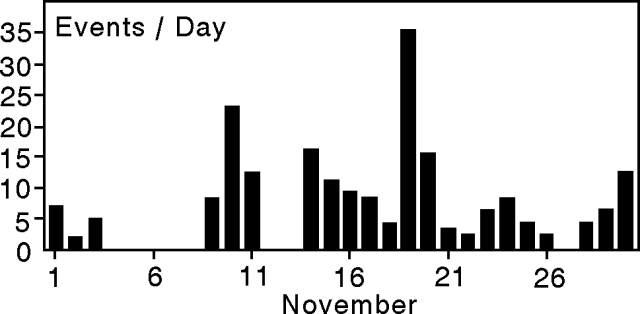Report on Arenal (Costa Rica) — December 1993
Bulletin of the Global Volcanism Network, vol. 18, no. 12 (December 1993)
Managing Editor: Edward Venzke.
Arenal (Costa Rica) Relatively few explosions, high tremor and continued lava emissions
Please cite this report as:
Global Volcanism Program, 1993. Report on Arenal (Costa Rica) (Venzke, E., ed.). Bulletin of the Global Volcanism Network, 18:12. Smithsonian Institution. https://doi.org/10.5479/si.GVP.BGVN199312-345033
Arenal
Costa Rica
10.463°N, 84.703°W; summit elev. 1670 m
All times are local (unless otherwise noted)
At Arenal hundreds to thousands of "seismic events" happen each month. The bulk of these events are thought to be caused by explosions associated with pyroclastic activity. In November the OVSICORI seismometer registered 203 seismic events (figure 65), the lowest total for any month thus far in 1993. For comparison, earlier in 1993 the same seismometer registered 2-7 times more events. In accord with the low number of seismic events, no one reported explosions or pyroclastic activity, although some minor pyroclastic flow deposits were recognized in the SW quadrant of the volcano.
 |
Figure 65. Arenal seismic events for November 1993 (received at station "VACR," 2.7 km NW of the active crater). Courtesy of OVSICORI. |
In contrast with the low number of seismic events, in November scientists reported high tremor (figure 66). The duration of tremor in November reached over 400 hours, a significant rise over the last several months. For comparison, tremor duration in 1993 reached its low in September at slightly over 100 hours, and reached its high in August at ~430 hours. In October and November lava issued from near 1,600 m elevation at the active vent, Crater C, and crept farther NE along the Tabacón river valley near 700 m elevation. Thus, the high tremor appears to correspond with continued lava emission, a common observation at Arenal.
Crater C generated a moderate explosion on 28 August, and since that time chiefly Strombolian-style eruptions have prevailed. On 24 August, 4 days before the explosion and the associated partial collapse the NW crater wall, OVSICORI found an usually large sub-radial length contraction in the SW quadrant. A length contraction corresponds to an inflation of the edifice. The length contraction (116 ± 3 ppm) was followed on 17 October by a length extension (102 ppm). Between 17 October and 5 December, tilt and deformation measurements in the SW quadrant revealed a 24.4 µrad deflationary tilt (equivalent to 5.0 ppm/month). Thus, deformation studies indicated that the SW quadrant inflated before the eruption and deflated after the eruption. These observations are consistent with transport and continued expulsion of molten material.
Geological Summary. Conical Volcán Arenal is the youngest stratovolcano in Costa Rica and one of its most active. The 1670-m-high andesitic volcano towers above the eastern shores of Lake Arenal, which has been enlarged by a hydroelectric project. Arenal lies along a volcanic chain that has migrated to the NW from the late-Pleistocene Los Perdidos lava domes through the Pleistocene-to-Holocene Chato volcano, which contains a 500-m-wide, lake-filled summit crater. The earliest known eruptions of Arenal took place about 7000 years ago, and it was active concurrently with Cerro Chato until the activity of Chato ended about 3500 years ago. Growth of Arenal has been characterized by periodic major explosive eruptions at several-hundred-year intervals and periods of lava effusion that armor the cone. An eruptive period that began with a major explosive eruption in 1968 ended in December 2010; continuous explosive activity accompanied by slow lava effusion and the occasional emission of pyroclastic flows characterized the eruption from vents at the summit and on the upper western flank.
Information Contacts: E. Fernández, J. Barquero, R. Van der Laat, F. de Obaldia, T. Marino, V. Barboza, and R. Sáenz, OVSICORI.


